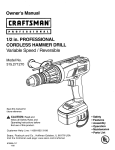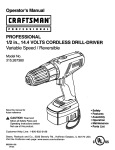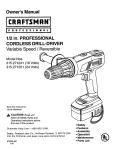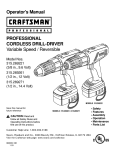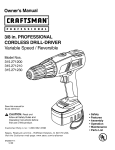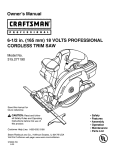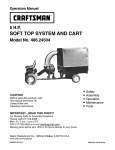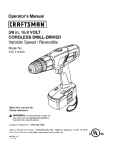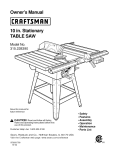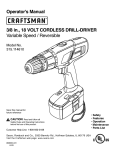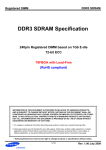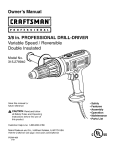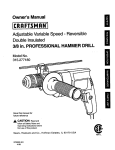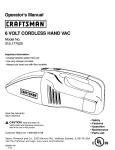Download Craftsman 315.271271 Owner`s manual
Transcript
Owner's Manual IPR 0 FESSl 0 HAL i 112 in., 18 VOLTS PROFESSIONAL CORDLESS HAMMER DRILL Variable Speed / Reversible Model No. 315.271271 Save this manual for _, future reference. • • • • • • CAUTION: Read and follow all Safety Rules and Operating Instructions before first use of this product. Customer Help Line: 1-800-932-3188 Sears, Roebuck and Co., Hoffman Estates, IL 60179 Visit the Craftsman web page: www.sears.com/craftsman 972000-822 2-01 USA Safety Features Assembly Operation Maintenance Parts List ® TABLE OF CONTENTS • General Safety Rules ................................................................................................................................................. 2-3 • Specific Safety Rules/Symbols .................................................................................................................................. 3-5 • Features ..................................................................................................................................................................... 5-8 • Assembly .................................................................................................................................................................. 9-10 • Operation ................................................................................................................................................................ 11-16 • Maintenance ................................................................................................................................................................ 17 • Accessories ....................................................................................................................... 18 • Warranty ...................................................................................................................................................................... 18 • Exploded View And Repair Parts List ......................................................................................................................... 19 • Parts Ordering/Service 20 .............................................................................................................................................. Personal _k WARNING: Read and understand all instructions. a=m Failure to follow all instructions listed below, may result in electric shock, fire and/or serious personal injury. SAVE THESE • • Keep your work area clean and well lit. Cluttered benches and dark areas invite accidents. • Do not operate power tools in explosive atmospheres, such as in the presence of flammable liquids, gases, or dust. Power tools create sparks which may ignite the dust or fumes. Keep bystanders, children, and visitors away while operating a power tool. Distractions can cause you to lose control. Electrical • • Do not abuse the cord. Never use the cord to carry the charger. Keep cord away from heat, oil, sharp edges, or moving parts. Replace damaged cords immediately. Damaged cords may create a fire. A battery operated tool with integral batteries or a separate battery pack must be recharged only with the specified charger for the battery. A charger that may be suitable for one type of battery may create a risk of fire when used with another battery. Use battery only with charger listed. MODEL BA'I-rERY PACK CHARGER • Item No. _9-11034 (981404-001) Stay alert, watch what you are doing and use common sense when operating a power tool. Do not use tool while tired or under the influence of • Dress properly. Do not wear loose clothing or jewelry. Contain long hair. Keep your hair, clothing, and gloves away from moving parts. Loose clothes, jewelry, or long hair can be caught in moving parts. • Avoid accidental starting. Be sure switch is in the locked or off position before inserting battery pack. Carrying tools with your finger on the switch or inserting the battery pack into a tool with the switch on, invites accidents. • Remove adjusting keys or wrenches before turning the tool on. A wrench or a key that is left attached to a rotating part of the tool may result in personal injury. • Do not overreach. Keep proper footing and balance at all times. Proper footing and balance enable better control of the tool in unexpected situations. • Use safety equipment. Always wear eye protection. Dust mask, non-skid safety shoes, hard hat, or hearing protection must be used for appropriate conditions. Safety 315.271271 Safety drugs, alcohol, or medication. A moment of inattention while operating power tools may result in serious personal injury. INSTRUCTIONS Work Area • _......................................... Item No. _9-11040 (981399-001) Use battery operated tool only with specifically designated battery pack. Use of any other batteries may create a risk of fire. Use only with battery pack listed. 2 Tool Use and Care • • • • • Use clamps or other practical way to secure and support the workpiece to a stable platform. Holding the work by hand or against your body is unstable and may lead to loss of control. Do not force tool. Use the correct tool for your application. The correct tool will do the job better and safer at the rate for which it is designed. Do not use tool if switch does not turn it on or off. A tool that cannot be controlled with the switch is dangerous and must be repaired. Disconnect battery pack from tool or place the switch in the locked or off position before making any adjustments, changing accessories, or storing the tool. Such preventivesafety measures reduce risk of startingthe tool accidentally. Store idle tools out of reach of children and other • Maintain tools with care. Keep cutting tools sharp and clean. Propedy maintained tools, with sharp cutting edges are less likely to bind and are easier to control. • Check for misalignment or binding of moving parts, breakage of parts, and any other condition that may affect the tool's operation. If damaged, have the tool serviced before using. Many accidents are caused by poorly maintained tools. • Use only accessories that are recommended by the manufacturer for your model. Accessories that may be suitable for one tool, may create a risk of injury when used on another tool. Service Tool service must be performed only by qualified repair personnel. Service or maintenance performed by unqualified personnel could result in a risk of injury. untrained persons. Tools are dangerous in the hands of untrained users. • When other nails, make When servicing a tool, use only identical replacement parts. Follow instructions in the Maintenance section of this manual. Use of unauthorized parts or failure to follow Maintenance Instructions may create a risk of shock or injury. battery pack is not in use, keep it away from metal objects like: paper clips, coins, keys, screws, or other small metal objects that can a connection from one terminal to another. Shorting the battery terminals together may cause sparks, burns, or a fire. Hold tool by insulated gripping surfaces when performing an operation where the cutting tool may contact hidden wiring. Contact with a "live" wire will make exposed metal parts of the tool "live" and shock the operator. Additional • • ing accessories. Following this rule will reduce the risk of electric shock, fire, or serious personal injury. Know your power tool. Read operator's manual carefully. Learn its applications and limitations, as well as the specific potential hazards related to this tool. Following this rule will reduce the risk of electric shock, fire, or serious injury. Make sure your extension cord is in good condition. When using an extension cord, be sure to use one heavy enough to carry the current your product will draw. A wire gage size (A.W.G.) of at least 16 is recommended for an extension cord 100 feet or less in length. A cord exceeding 100 feet is not recommended. If in doubt, use the next heavier gage. The smaller the gage number, the heavier the cord. An undersized cord will cause a drop in line voltage resulting in loss of power and overheating. Important • Rules For Safe Operation Rules for Battery Tools Battery tools do not have to be plugged into an electrical outlet; therefore, they are always in operating condition. Be aware of possible hazards when not using your battery tool or when chang3 • Do not place battery tools or their batteries near fire or heat. They may explode. Following this rule will reduce the risk of electric shock, fire, or serious personal injury. • Do not charge battery tool in a damp or wet location. Following this rule will reduce the risk of electric shock, fire, or serious personal injury. • Your battery tool should be charged in a location where the temperature is more than 50°F but less than IO0°F. Following this rule will reduce the risk of electric shock, fire, or serious personal injury. • Under extreme usage or temperature conditions, battery leakage may occur. If liquid comes in contact with your skin, wash immediately with soap and water, then neutralize with lemon juice or vinegar. If liquid gets into your eyes, flush them with clean water for at least 10 minutes, then seek immediate medical attention. Following this rule will reduce the risk of serious personal injury. Important • Safety Instructions Save these instructions. This manual contains important safety and operating instructions for battery charger part number 9_-11040 (981399-001). Following this rule will reduce the risk of electric shock, fire, or serious personal injury. • Before using battery charger, read all instructions and cautionary markings in this manual, on battery charger, and product using battery charger. Following this rule will reduce the risk of electric shock, fire, or serious personal injury. • To reduce risk of injury, charge only nickelcadmium and nickel metal hydride type rechargeable batteries. Other types of batteries may burst causing personal injury and damage. Following this rule will reduce the risk of electric shock, fire, or serious personal injury. • • c. That wire size is large enough for AC ampere rating of charger as specified below: For Charger • • stepped on, tripped over, or otherwise subjected to damage or stress. Following this rule will reduce the risk of serious personal injury. 'An extension cord should not be used unless 100' Cord Size (AWG) 16 16 16 Do not operate charger with a damaged cord or plug. If damaged, have replaced immediately by a qualified serviceman. Following this rule will reduce the risk of electric shock, fire, or serious personal injury. • Do not operate charger if it has received a sharp blow, been dropped, or otherwise damaged in any way; take it to a qualified serviceman. Following this rule will reduce the risk of electric shock, fire, or serious personal injury. • Do not disassemble charger; take it to a qualified serviceman when service or repair is required. Incorrect reassembly may result in a risk of electric shock or fire. Following this rule will reduce the risk of electric shock, fire, or serious personal injury. or sold To reduce risk of damage to charger body and cord, pull by charger plug rather than cord when disconnecting charger. Following this rule will reduce the risk of electric shock, fire, or serious personal injury. Make sure cord is located so that it will not be 50' • by the battery charger manufacturer may result in a risk of fire, electric shock, or injury to persons. Following this rule will reduce the risk of electric shock, fire, or serious personal injury. • 25' Note: AWG = American Wire Gage Do not expose charger to rain or snow. Following this rule will reduce the risk of electric shock, fire, or serious personal injury. Use of an attachment not recommended Cord Length (Feet) To reduce the risk of electric shock, unplug charger from outlet before attempting any maintenance or cleaning. Turning off controls will not reduce this risk. Following this rule will reduce the risk of electric shock, fire, or serious personal injury. absolutely necessary. Use of improper extension cord could result in a risk of fire and electric shock. If extension cord must be used, make sure: • Do not use charger outdoors. Following this rule will reduce the risk of electric shock, fire, or serious personal injury. • Disconnect charger from power supply when not in use. Following this rule will reduce the risk of electric shock, fire, or serious personal injury. ,_ DANGER: RISK OF ELECTRIC SHOCK. DO NOT TOUCH UNINSULATED PORTION OF OUTPUT CONNECTOR OR UNINSULATED BAI-rERY TERMINAL. Save these instructions. Refer to them frequently and use them to instruct others who may use this tool. If you loan someone this tool, loan them these instructions also. Following this rule will reduce the risk of electric shock, fire, or serious personal injury. a. That pins on plug of extension cord are the same number, size and shape as those of plug on charger. b. That extension cord is properly wired and in good electrical condition; and 4 _' a_ WARNING: Some dust created by I_ower sanding, sawing, grinding, drilling, and other construction activities conta!ns chem ca s known to cause cancer, birth defects or other reproductive harm. Some examples of these chemicals are: • lead from lead-based paints, • crystalline silica from bricks and cement and other masonry products, and • arsenic and chromium from chemically-treated lumber. Your risk from these exposures varies, depending on how often you do this type of work. To reduce your exposure to these chemicals: work in a well ventilated area, and work with approved safety equipment, such as those dust masks that are specially designed to filter out microscopic particles. SYMBOLS SYMBOL NAME DESIGNATION/EXPLANATION V Volts Voltage A Amperes Current Hz Hertz Frequency (cycles per second) min Minutes Time "_ Alternating Current Type or a characteristic of current --=- Direct Current Type or a characteristic of current no No Load Speed Rotational speed, at no load .../min Revolutions or Reciprocation Per Minute Revolutions, strokes, surface speed, orbits etc. per minute _I, Safety Alert Symbol Indicates danger, warning or caution. It means attention!!! Your safety is involved. DEFINITIONS A) DANGER: Failure to obey a safety warning will result in serious injury to yourself or to others. Always follow the safety precautions to reduce the risk of fire, electric shock and personal injury, B) WARNING: Failure to obey a safety warning can result in serious injury to yourself or to others. Always follow the safety precautions to reduce the risk of fire, electric shock and personal injury. c) CAUTION: Failure to obey a safety warning may result in property damage or personal injury to yourself or to others. Always follow the safety precautions to reduce the risk of fire, electric shock and personal injury. B) NOTE: Advises you of information or instructions vital to the operation or maintenance of the equipment, 5 KNOWYOURHAMMERDRILL BIT STORAGE See Figure 1. When not in use, bits provided with your hammer drill can be placed in the storage area located on the top of the motor housing. Before attempting to use your hammer drill, familiarize yourself with all operating features and safety requirements, _i WARNING: Carefully read through this entire owner's manual before using your new hammer drill. Pay close attention to the Rules For Safe Operation, Wamings and Cautions. If you use your hammer drill properly and only for what it is intended, you will enjoy years of safe, reliable service. LEVEL To keep drill bit level during drilling operations, a level is located on the top and end of the motor housing. AUXILIARY An auxiliary handle is packed with your hammer drill for ease of operation and to help prevent loss of control. DEPTH ,_ WARNING: Do not allow famUiarity with your hammer drillto make you careless. Remember that a careless fraction of a second is sufficientto inflictsevere injury. KEYLESS CHUCK Your hammer drill has a keyiess chuck that allows you to hand tighten or release drill bit in the chuck jaws. HANDLE GAGE ROD A depth gage rod has been packed with your hammer drill to assist you in controlling the depth of drilled holes. _1, WARNING: If any parts are missing, do not operate your hammer drill until the missing parts are replaced. Failure to do so could result in possibleserious personal injury. SWITCH PRODUCT To turn your hammer drill ON, depress the switch trigger. Release switch trigger to turn your hammer drill OFF. SWITCH LOCK The switch trigger can be locked in the OFF position. This feature helps reduce the possibility of accidental starting tool when not in use. VARIABLE SPEED DRILL GEAR TRAIN 1/2 in. Keyless Motor DC Motor 18 Volts Gear Train No Load Speed Hammer Speed FORWARD/REVERSE Maximum Torque above the switch trigger. WRIST 0-6,400 (Low) 0-22,400 (High) 24 Positions CHARGER 449 in./Ibs. ITEM NO. _9-11040 (981399-001 Charging Voltage Charge Rate BA'n'ERY ) 120 V, 60 Hz, AC only Input STRAP A wrist strap is provided to reduce the chances of dropping your hammer drill. Place one hand through the wrist strap when carrying tool. 0-400 RPM (Low) 0-1400 RPM (High) Clutch (DIRECTION OF ROTATION SELECTOR) Your hammer drill has a forward/reverse selector located Two Speed Variable Speed Your hammer drill has a two speed gear train designed for drilling or driving at HI or LO speeds. A slide switch is located on top of your drill to select either HI or LO speed. SELECTOR 315.271271 Chuck Switch This tool has a variable speed switch that delivers higher speed with increased trigger pressure. Speed is controlled by the amount of switch trigger depression. TWO SPEED HAMMER SPECIFICATIONS: PACK 9.6 - 24 Volts 1 Hour ITEM NO. _9-11034 (981404-001) TWOSPEED GEAR TRAIN (HI-LO) AUXILIARY HANDLE LEVEL WING SCREW BIT STORAGE AREA DEPTH GAGE ROD KEYLESS CHUCK DIRECTION OF ROTATION SELECTOR (FORWARD/REVERSE) MODE SELECTOR TORQUE TRIGGER ADJUSTMENT RING BATTERY PACK WRIST STRAP :_ SCREWDRIVER BITS Fig.1 7 LED FUNCTION OF CHARGER YELLOWLIGHT"ON" AND RED LIGHTFLASHINGINDICATES DEFECTIVEBATTERYPACK CHARGER \ CHARGER RED LIGHT"ON" FASTCHARGINGMODE GREENLIGHT"ON" INDICATESFULLY CHARGEDANDSLOWCHARGING TO MAINTAINBATTERYPACK CHARGER See Figure 3. Your charger has a "key hole" hanging feature for convenient, space saving storage. Screws should be installed so that center distances are 4-1/8 inches apart. 4-1/8in. BACKSIDE OF CHARGER Fig. 3 8 BATTERYPACKSHOWN IN CHARGER Fig. 2 AUXILIARY HANDLE • Lock the switch trigger by placing the direction of rotation selector in center position. See Figure 13. • Align raised ribs on battery pack with grooves on bottom of drill, then attach battery pack to drill as shown in Figure 5. Make sure latch on battery pack snaps into place and battery pack is secured to drill before beginning operation. See Figure 4. An auxiliary handle is packed with your drill for ease of operation and to help prevent loss of control. The handle can be rotated 360 ° and it can also be mounted on opposite side for left hand use. • Note: For convenience and ease of starting threads, the hex nut has been trapped inside the molded slot in the auxiliary handle. TO INSTALL: • RAISEDRIBS Lock the switch trigger by placing the direction of rotation selector in center position. See Figure 13. • • Loosen wing screw enough to make ring of handle large enough to fit over chuck. Place ring of handle over the chuck and mode selector. Note: Handle fits in a groove behind torque adjusting ring. • Rotate handle to desired angle. • Tighten wing screw securely. Note: If wing screw and wear plate is removed from auxiliary handle, when reassembling, the markings on the wear plate must be positioned as shown in Figure 4. This prevents the depth gage rod from slipping. See Figure 4. WINGSCREW TO LATCH BATTERYPACK A TORUE KEYLESS ADJUSTING CHUCK RING GROOVE TIGHTEN_ CAUTION: When attaching battery pack to your drill, be sure raised ribs and grooves align properly and latch snaps into place properly. Improper assembly can cause damage to drill and battery pack. TO REMOVE TO LOOSEN Fig. 5 BATTERY PACK FROM DRILL See Figure 6. 360° MODE SELECTOR • Lock the switch trigger by placing the direction of rotation selector in center position. See Figure 13. • Depress latch located on front of battery pack (1) to release battery pack. • Pull forward on battery pack (2) to remove from drill. DEPRESSLATCHTO RELEASEBATTERYPACK RAISEDRIB AUXILIARY HANDLE MARKINGSON BACKSIDE OFWEAR PLATE Fig. 4 To prevent possible loss of control, auxiliary handle should be checked periodically for tightness. Do not operate hammer drill with auxiliary handle loose. TO ATTACH BATTERY PACK TO DRILL See Figure 5. PULL FORWARD TO REMOVE Note: Battery pack is shipped in a low charge condition. Therefore, it must be charged priorto use. Refer to page 11, "CHARGING BA'I-rERY PACK" for charging instructions. BATTERYPACK Fig. 6 INSTALLINGBITS REMOVING See Figure 7. See Figure 7. • Lock the switch trigger by placing the direction of rotation selector in center position. See Figure 13. • Lock the switch trigger by placing the direction of rotation selector in center position. See Figure 13. • Open or close chuck jaws to a point where the opening is slightly larger than the bit size you intend to use. Also, raise the front of your drill slightly to keep the bit from falling out of the chuck jaws. • Loosen the chuck jaws from drill bit. • To loosen, grasp and hold the drill with one hand, while rotating chuck sleeve with your other hand. Note: Rotate chuck sleeve in the direction of the arrow marked UNLOCK to loosen the chuck jaws. • Do not use a wrench to tighten or loosen the chuck jaws. • Remove drill bit from chuck jaws. • Insert drill bit straight into chuck the full length of the jaws as shown in Figure 7. CHUCKJAWS \ UNLOCK USING DEPTH GAGE ROD See Figure 9. A depth gage rod has been packed with your hammer drill to assist you in controlling the depth of drilled holes. • Loosen wing screw on auxiliary handle. • Orient depth gage rod so that markings on depth gage rod face markings on wear plate. See Figure 4. Insert depth gage rod through hole on auxiliary handle. • Adjust depth gage rod so that the drill bit extends beyond the end of the rod to the required ddlling depth. • Tighten wing screw securely. This secures depth gage rod at desired depth of cut. It also secures auxiliary handle. DRILLBIT LOCK CHUCKSLEEVE RIGHT • BITS Fig. 7 Tighten the chuck jaws on drill bit. To tighten, grasp and hold the drill with one hand, while rotating the chuck sleeve with your other hand. WING SCREW Note" Rotate the chuck sleeve in the direction of the arrow marked LOCK to tighten chuck jaws. • ,_ WEAR PLATE Do not use a wrench to tighten or loosen the chuck jaws. DRILLBIT WARNING: Make sure to insert drill bit straight into chuck jaws. Do not insert drill bit into chuck jaws at an angle and then tighten, as shown in Figure 8. This could cause drill bit to be thrown from drill, resulting in possible serious personal injury or damage to the chuck. TO DEPTH DRILLING DEPTH DRILLING DEPTH MARKINGSON DEPTHGAGEROD AUXILIARY HANDLE Fig. 9 When drilling holes with the depth gage rod installed, the desired hole depth has been reached when the end of the rod comes in contact with the surface of the material being drilled. Fig. 8 10 ,_ If after one hour red light is still flashing, this indicates a defective battery pack and should be replaced. WARNING: Always wear safety goggles or safety glasses with side shields when operating tools. Failure to do so could result in objects being thrown into your eyes, resulting in possible serious injury. CHARGING BATI'ERY Green light on indicates battery pack is fully charged and slow charging to maintain battery pack. Yellow light on and red light flashing indicates defective battery pack. Return battery pack to your nearest Sears Repair Center for checking or replacing. PACK The battery pack for this tool has been shipped in a low charge condition to prevent possible problems. Therefore, you should charge it until light on front of charger changes from red to green. Note: Batteries will not reach full charge the first time they are charged. Allow several cycles (drilling followed by recharging) for them to become fully charged. TO CHARGE • Charge battery pack only with the charger provided. • Make sure power supply is normal house voltage, 120 volts, 60 Hz, AC only. • Connect charger to power supply. • Attach battery pack to charger by aligning raised ribs on battery pack with grooves in charger, then slide battery back onto charger. See Figure 10. When your battery pack becomes fully charged, the red light will rum OFF and the green light will rum ON. • After normal usage, 1 hour of charging time is required to be fully charged. A minimum charge time of 1-1/2 hours is required to recharge a completely discharged tool. • The battery pack will become slightly warm to the touch while charging. This is normal and does not indicate a problem. • Do not place charger in an area of extreme heat or cold. It will work best at normal room temperature. • When the batteries become fully charged, unplug your charger from power supply and remove the battery pack. LED FUNCTION OF CHARGER LED WILL BE LIGHTED TO INDICATE STATUS OF CHARGER AND BATTERY PACK: BA'n'ERY PACK TO REMOVE CHARGER • Red LED Lighted = Fast Charging Mode. • Green LED Lighted = Fully Charged And Slow Charging To Maintain Battery Pack. • Red LED Flashing = Hot Or Deeply Discharged Battery Pack. Also Defective Battery Pack After 1 Hour. • Yellow LED Lighted and Red LED Flashing = Defective Battery Pack. IMPORTANT INFORMATION HOT BATTERIES ro ATTACH FOR RECHARGING Under extreme continuous use, the batteries in your battery pack will become hot. You should let a hot battery pack cool down for approximately 1 hour before attempting to recharge. When the battery pack becomes discharged and is hot, this will cause the red light on your battery charger to flash. When battery pack cools down, red light will glow continuously indicating fast charging mode, 1 hour charge time. Once the battery pack cools down, it will recharge battery pack in fast charging mode as normal. GROOVES Fig. 10 • • Red light should turn on. Red light indicates fast charging mode. Note: This situation only occurs when extreme continuous use of your drill causes the batteries to become hot. It does not occur under normal circumstances. Refer to If red light is flashing, this indicates battery pack is deeply discharged or hot. If battery pack is hot, red light should become steady after battery pack has cooled down. "CHARGING BATTERY PACK" for normal recharging of batteries. If the charger does not charge your battery pack under normal circumstances, return both the battery pack and charger to your nearest Sears repair center for electrical check. If battery pack is deeply discharged, red light should become steady after voltage has increased, normally within 60 minutes. 11 SWITCH See Figure 11. SWITCH LOCK To turn your drill ON, depress the switch trigger. To turn it OFF, release the switch trigger. The switch trigger can be locked in the OFF position. This feature can be used to prevent the possibility of accidental starting when not in use. To lock switch trigger, place the direction of rotation selector in center position. See Figure 13. FORWARD/REVERSE SELECTOR SELECTOR CENTERPOSITION CENTERPOSITION (LOCK) SWlTC TRIGGER VARIABLE Fig. 11 FORWARD SPEED ,_ This tool has a variable speed switch that delivers higher speed and torque with increased trigger pressure. Speed is controlled by the amount of switch trigger depression. SPEED See Figure 13. This tool has the feature of being reversible. The direction of rotation is controlled by a selector located above the switch trigger. With the drill held in normal operating position, the direction of rotation selector should be positioned to the left of the switch for drilling. The drilling direction is reversed when the selector is to the right of the switch. When the selector is in center position, the switch trigger is locked. GEAR TRAIN See Figure 12: Your drill has a two-speed gear train designed for drilling or driving at LO (1) or HI (2) speeds. A slide switch is located on top of your drill to select either LO (1) or HI (2) speed. When using drill in the LO (1) speed range, speed will decrease and unit will have more power and torque. When using drill in the HI (2) speed range, speed will increase and unit will have less power and torque. Use LO (1) speed for high power and torque applications and HI (2) speed for fast drilling or driving applications. TWO SPEED GEARTRAIN(HI-LO) WARNING: Battery tools are always in operating condition. Therefore, switch should always be locked when not in use or carrying at your side. REVERSIBLE Note: You might hear a whistling or ringing noise from the switch during use. Do not be concerned, this is a normal part of the switch function. TWO Fig. 13 _i CAUTION: To prevent gear damage, always allow chuck to come to a complete stop before changing the direction of rotation or the two speed gear train (hi-lo). To stop, release switch trigger and allow the chuck to come to a complete stop. LO SPEED HI SPEED Fig. 12 12 KEYLESS TO DECREASE ADJUSTINGRING TORQUE CHUCK See Figure 14. A keyless chuck has been provided with your drill to allow for easy installation and removal of bits. As the name implies, you can hand tighten or release drill bits in the chuck jaws. Arrows on the chuck indicate which direction to rotate the chuck sleeve in order to LOCK (tighten) or UNLOCK (release) the chuck jaws. Loosen the chuck sleeve by rotating it counterclockwise with one hand. Insert drill bit straight into the chuck the full length of the jaws, and tighten securely by rotating the chuck sleeve in clockwise direction. CHUCKJAWS TOINCREASE TORQUE UNLOCK Fig. 15 Note: Remember the two-speed feature (HI-LO) when setting torque. The amount of torque will vary depending on which speed setting you have your drill. Switching to LO speed will increase torque. Switching to HI speed will decrease torque. BIT STORAGE See Figure 16. DRILLBIT LOCK (Tighten) CHUCKSLEEVE RIGHT _ When not in use, bits provided with your drill can be placed in the storage area located on the top of your drill as shown in Figure 16. BIT STORAGEAREA Fig. 14 SCREWDRIVER BIT WARNING: Do not hold chuck sleeve with one hand and use power of the drill to tighten chuck jaws on drill bit. Chuck sleeve could slip in your hand or your hand could slip and come in contact with rotating drill bit. This could cause an accident resulting in serious personal injury. ADJUSTABLE TORQUE SCREWDRIVER BIT CLUTCH Your drill is equipped with an adjustable torque clutch for driving different types of screws into different materials. The proper setting depends on the type of material and the size of screw you are using. TO ADJUST Fig. 16 TORQUE • Identify the twenty four torque indicator settings located on the front of your drill. See Figure 15. • Rotate adjusting ring to the desired setting. • 1 - 4 For driving small screws. • 5 - 8 For driving screws into soft material. 9 - 12 For driving screws into soft and hard materials. • 13 - 16 For driving screws in hard wood. • 17 - 20 For driving large screws. • 21 - ,_1 For heavy drilling. 13 DRILLING APPLICATIONS See Figure 18. (Use only for the purposes listed below) END VIEW • Hammer drilling in concrete and masonry. • Drilling in wood. • Drilling in ceramics, plastics, fiberglass, and laminates. • Drilling in both hard and soft metals. • Using driving accessories, such as driving screws with screwdriver bits. LEVEL LEVEL DRILLING See Figure 17. A convenient feature provided on your drill is a level. It is recessed in the motor housing on top and end of your drill. It can be used to keep drill bits level during most drilling operations. TOP VIEW Fig. 18 LEVEL When drilling hard smooth surfaces use a center punch to mark desired hole location. This wilt prevent the drill bit from slipping off center as the hole is started. However, the low speed feature allows starting holes without center punching if desired. To accomplish this, simply operate your drill at a low speed until the hole is started. The material to be drilled should be secured in a vise or with clamps to keep it from turning as the drill bit rotates. Hold tool firmly and place the bit at the point to be drilled. Depress the switch trigger to start tool. Move the drill bit into the workpiece applying only enough pressure to keep the bit cutting. Do not force or apply side pressure to elongate a hole. _i Fig, 17 WARNING: Be prepared for binding or bit breakthrough. When these situations occur, drill has a tendency to grab and kick opposite to the direction of rotation and could cause loss of control when breaking through material. If not prepared, this loss of control can result in possible serious injury. When drilling metals, use a light oil on the drill bit to keep it from overheating. The oil will prolong the life of the bit and increase the drilling action. If the bit jams in workpiece or if the drill stalls, release switch trigger immediately. Remove the bit from the workpiece and determine the reason for jamming. 14 TO ADJUST DRILLING See Figure 19. OR HAMMER WOOD MODE To adjust drill to drilling or hammer operation, rotate mode selector in the direction of arrows as shown in Figure 19. For your convenience a hammer symbol and drill bit symbol have been molded into the selector. DRILLING • For maximum performance, use high speed steel bits for wood drilling. • Turn mode selector ring on hammer drill to normal drilling action. • Begin drilling at a very low speed to prevent the bit from slipping off the starting point. Increase the speed as the drill bit bites into the material. • When drilling through holes, place a block of wood behind the workpiece to prevent ragged or splintered edges on the back side of the hole. • Do not lock the trigger on for jobs where your hammer drill may need to be stopped suddenly. WARNING: Your hammer drill has not been designed for reverse hammering. Reverse hammering may damage your drill. MODE SELECTOR METAL • For maximum performance, use high speed steel bits for metal or steel drilling. • Turn mode selector on hammer drill to normal drilling action. • Begin drilling at a very low speed to prevent the bit from slipping off the starting point. • Maintain a speed and pressure which allows cutting without overheating the bit. Applying too much pressure will: • Overheat the drill; Fig. 19 We recommend that you use carbide-tipped bits and select hammer mode when drilling in hard materials such as brick, tile, concrete, etc. • We recommend that you select normal drilling mode when drilling with twist drills, hole saws, etc. in steel and soft materials. DRILLING • • Wear the bearings; Bend or burn bits; and • Produce off-center or irregular shaped holes. When drilling large holes in metal, we recommend that you drill with a small bit at first, then finish with a larger bit. Also, lubricate the bit with oil to improve drilling action and increase bit life. MASONRY 15 DRILLING • For maximum performance use carbide-tipped masonry impact bits when drilling holes in brick, tile, concrete, etc. • Turn mode selector on hammer drill to hammer mode. Rotate torque selector to drill position. • Apply light pressure and medium speed for best results in brick. • Apply additional pressure and high speed for hard materials such as concrete. • When drilling holes in tile, practice on a scrap piece to determine the best speed and pressure. See Figures 20, 21, and22. Insert hex key wrench in chuck and tighten chuck jaws securely. Tap sharply with a mallet in a counterclockwise direction. This will loosen chuck on the The chuck must be removed in order to use some accessories. To remove: spindle. It can now be unscrewed by hand. See Figure 22. CHUCK REMOVAL • Lock the switch trigger by placing the direction of rotation selector in center position. See Figure 13. • Insert a 5/16 inch or larger hex key wrench into the chuck of your drill and tighten the chuck jaws securely. • Tap the wrench sharply with a mallet in a clockwise direction. See Figure 20. This will loosen the screw in the chuck for easy removal. MALLET CHUCKJAWS \ Fig. 22 HI WRENCH TO RETIGHTEN KEYLESS CHUCK A LOOSE CHUCK The chuck may become loose on spindle and develop a wobble. Periodically check chuck screw for tightness. A loose chuck screw may cause the chuck jaws to bind and prevent them from closing. Fig. 20 Open chuck jaws and remove wrench. Remove the chuck screw by turning it in a clockwise direction. See Figure 21. To tighten, follow these steps: Note: The screw has left hand threads. • Lock the switch trigger by placing the direction of rotation selector in center position. See Figure 13. • Open the chuck jaws. • Insert hex key wrench into chuck and tighten chuck jaws securely. Tap wrench sharply with a mallet in a clockwise direction. This will tighten chuck on the spindle. • Open the chuck jaws and remove wrench. • Tighten the chuck screw. Note: The chuck screw has left hand threads. SCREWDRIVER Fig. 21 16 _k, WARNING: When servicing use only Identical Craftsman replacement parts. Use of any other pads may create a hazard or cause product damage. Avoid using solvents when cleaning plastic pads. Most plastics are susceptible to damage from various types of commercial solvents and may be damaged by their use. Use clean cloths to remove dirt, carbon dust, etc. A Do not abuse power tools. Abusive practices can damage tool as well as workpiece. Only the parts shown on parts list, page 19, are intended to be repaired or replaced by the customer. All other parts should be replaced at a Sears Service Center. _L WARNING: Do not attempt to modify this tool or create accessories not recommended for use with this tool. Any such alteration or modification is misuse and could result in a hazardous condition leading to possible serious personal injury. • Store and charge your batteries in a cool area. Temperatures above normal room temperature will shorten battery life. • Never store batteries in a discharged condition. Recharge them immediately after they are discharged. • All batteries gradually lose their charge. The higher the temperature the quicker they lose their charge. If you store your tool for long periods of time without using it, recharge the batteries every month or two. This practice will prolong battery life. WARNING: Do not at any time let brake fluids, gasoline, petroleum-based products, penetrating oils, etc. come in contact with plastic pads. They contain chemicals that can damage, weaken, or destroy plastic. BATTERIES The battery pack for your drill is equipped with nickelcadmium rechargeable batteries. Length of service from each charging will depend on the type of work you are doing. The batteries in this tool have been designed to provide maximum trouble free life. However, like all batteries, they will eventually wear out. Do not disassemble battery pack and attempt to replace the batteries. Handling of these batteries, especially when wearing rings and jewelry, could result in a serious burn. To obtain the longest possible battery life, we suggest the following: BA'n'ERY PACK FOR RECYCLING To preserve natural resources, please recycle or dispose of properly. This product contains nickel-cadmium batteries. Local, state or federal laws may prohibit disposal of nickel-cadmium batteries in ordinary trash. REMOVAL AND PREPARATION WARNING: Upon removal, cover the battery pack's terminals with heavy duty adhesive tape. Do not attempt to destroy or disassemble battery pack or remove any of its components. Nickel-cadmium batteries must be recycled or disposed of properly. Also, never touch both terminals with metal objects and/or body parts as short circuit may result. Keep away from children. Failure to comply with these warnings could result in fire and/or serious injury. Consult your local waste authority for information regarding available recycling and/or disposal options. 17 The following recommended accessories are currently available at Sears Retail Stores. M 6-Pc. Extra Length Magnite Power Bit Set • High Speed Bits......1/2 in. Max. • 30-Pc. Power Screwdriver/Nutdriver Set and Case • Wood Boring Bits ...... 1-1/4 in. Max. • 17-Pc. Power Screwdriver/Nutdriver Set and Case • Masonry Bits......1/2 in. Max. _lb WARNING" The use of attachments or accessories not listed might be hazardous. WARNING: The operation of any power tool can result in severe eye damage. Before safety glasses with side shields and Safety Mask for use over eyeglasses Retail Stores. result in foreign objects being thrown into your eyes, which can beginning power tool operation, always wear safety goggles or a full face shield when needed. We recommend Wide Vision or standard safety glasses with side shields, available at Sears WARRANTY FULL ONE YEAR WARRANTY ON CRRFTSMRN PROFESSIONAL CORDLESS HAMMER DRILL If this rRRFI"$MRN Professional Cordless Hammer Drill fails due to a defect in material or workmanship within one year from the date of purchase, Sears will repair it, free of charge. WARRANTY SERVICE IS AVAILABLE BY SIMPLY RETURNING SEARS SERVICE CENTER IN THE UNITED STATES. THE TOOL TO THE NEAREST SEARS STORE OR This warranty gives you specific legal rights, and you may also have other rights which vary from state to state. Sears, Roebuck and Co., Dept. 817WA, Hoffman Estates, IL 60179 SAVE THESE INSTRUCTIONS 18 CRAFTSMAN 112 in., 18 VOLTS PROFESSIONAL CORDLESS MODEL NO. 315.271271 HAMMER DRILL I I I in all correspondence regarding your CRAFTSMAN 1/2 in., 18 VOLTS PROFESSIONAL CORDLESS The model number willbe on a plate HAMMER DRILL or whenfound ordering repairattached parts. to the motor housing. Always mention the model number SEE BACK PAGE FOR PARTS ORDERING | INSTRUCTIONS 3 2 1 4 7 \ 6 \ Q PARTS Key No. LIST PaN Number Description 1 975379-000 Screw (Special) ............................................................................................. 1 2 982391-001 Auxiliary Handle Assembly ............................................................................ 1 3 975111-001 1/2 in. Chuck (Item No. _9-20956) .................................................................. 1 4 981501-001 Logo Plate ..................................................................................................... 1 Battery Pack (981404-001) ........................................................................... 1 Depth Gage Rod ........................................................................................... 1 Battery Charger (981399-001) ...................................................................... 1 981500-001 Carrying Case - Not Shown .......................................................................... 1 972000-822 Owner's Manual 5 6 7 8 * -9-11034 980199-000 * -9-11040 Quan. * Can Be Purchased At Your Nearest Sears Retail Store 19 For repair of major brand appliances in your own home... no matter who made it, no matter who sold it! 1-800-4-MY-HOME sMAnytime, day or n,ght (1-800-469-4663) www.sears.com To bring in products such as vacuums, lawn equipment and electronics for repair, call for the location of your nearest Sears Parts & Repair Center. 1-800-488-1222 Anyt, me,dayor mght www,sears.com For the replacement parts, accessories and owner's manuals that you need to do-it-yourself, call Sears PartsDirect sM! 1-800-366-PART 6 a.m. - 11 p m. CST, (1-800-366-7278) 7 days a week www.sears.com/partsdirect To purchase or inquire about a Sears Service Agreement: 1-800-827-6655 7 a.m. - 5 pm. CST, Mon.- Para pedlr servlclo de reparaci6n a domlolho, y para ordenar plezas con entrega a domlclho 1-888-SU-HOGAR s,_ Sat. Au Canada pour service en fran_ais" 1-877-LE-FOYERS" (1-877-533-6937) (1-888-784-6427) SEARS ] H°meCentral_ J ® Registered Tradernar_ / T_ Trademark of Sears, Roebuck ar_ Co _) Sears ROebL_cKand Co ® Marca Reglstrada / T_, Ma_'ca de F_brlca de Sears Roebuck and Co




















